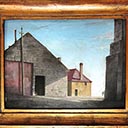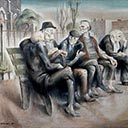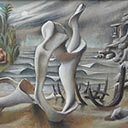Transition No. 8 (Creation Cycle)
54.4 x 84.7 cm
est. $20,000 - 30,000
PROVENANCE
Private Collection, Northland. Purchased from Rotorua's Art & History Museum exhibition 1989 Painted at 117 New Kings Road studio, Fulham, London
EXHIBITED
Edward Bullmore, One Decade On, The Bath-House, Rotorua's Art & History Museum, 15 November 1988 8 February 1989
The Transition Series: London 1960-61, Canterbury Gallery, Christchurch
Edward Bullmore: A Surrealist Odyssey, Tauranga Art Gallery 2008
Transition No. 8 is representative of how Bullmore perceived London in the early sixties. As Bullmore's political awareness grew he saw London and Britain as places in transition. The premonition of the nuclear age was very real and alarming for Bullmore and his expatriate artist friends such as Pat Hanly and Ralph Hotere. On April 18th, 1960 an estimated 100,000 people gathered in Trafalgar Square to protest against the H-bomb. This event made a huge impression on Bullmore.
Transition was the title he gave this major series, consisting of nine works painted between 1960 - 1961. These years marked Bullmore's complete stylistic transition from regional realism with biomorphic objects (as in Self Portrait 1959) to a more highly developed surrealism in which he looked outwards at the world, depicting suffering and collective anxieties in a real sense rather than a personal or spiritual sense. The Transition Series also symbolised Bullmore's personal transition from art teacher and part time provincial New Zealand artist, to that of a professional artist exhibiting in London.
The work is symbolic of his transitioning from the teachings of Bill Sutton and Russell Clark. More specifically, Transition No. 8 is about the transition between creation and death. Made up of three parts, this work is a narrative - an idea perhaps gleaned from works such as Masaccio's (1401-28) The Rendering of the Tribute Money (which Bullmore would have been familiar with from his time in Florence). Bullmore's Adam and Eve, alone and banished from the Garden of Eden, rest on a small island, marooned for their sins. On the right hand side, a large androgynous head acts as a surveyor of the scene; this head appears in other works from the same series and is a precursor to the more skeletal heads, that have been exposed to nuclear war, seen in the Cuba Crisis Series (1962). It would appear the sea is the only constant in this desolate scene.
There are recurring motifs throughout this series, such as the head, situated in imagined spaces, including landscapes. Each motif is symbolic such as the boat wreck, eroded over time, which references decline and death. Bullmore included Old Testament characters as metaphors, applying them to a greater and more contemporary issue, that of nuclear armament and warfare. Stylistically Bullmore's work at this time was influenced by Italian artist, Giorgio de Chirico (1888 - 1978).
The current owner purchased Transition No. 8 in 1989, from One Decade On. Jacqueline Bullmore gave the subtitle, Creation Cycle to the work subsequent to Bullmore's death. Penelope Jackson





